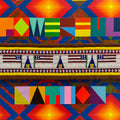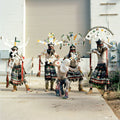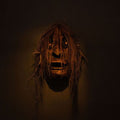Step by Step
By Medicine Man Gallery on
The art of Collecting Antique Navajo Weavings
When I began collecting vintage Navajo blankets and rugs 30-plus years ago, there was no guidebook or database on buying or pricing a Navajo weaving, not to mention understanding how to verify authenticity.Of course, this was before the internet, and the only references were a few books, museum stores and dealers. Therefore, I needed to develop an objective set of criteria to help solidify a repeatable roadmap for every rug I purchased. Since beginning this journey,
I have purchased thousands of antique Navajo blankets and rugs, and realized I repeatedly used the same parameters. These parameters apply to Navajo textiles dated from the 1950s and earlier, as contemporary weavings differ regarding the artist’s reputation and skill.
I looked, listened, handled and read as much as I could for two years before purchasing my first Navajo rug. When I finally decided, I had a critical mass of knowledge, I bought a dozen weavings in one weekend and was off to the races. In today’s world, collectors can condense much of this learning curve thanks to many excellent YouTube videos on collecting and the multitude of auction databases on which to search and compare pricing. However, I will warn you that looking online at weavings will only take you so far in the learning curve. At some point, you must get down on the ground, touch the weavings and look at the construction; a hands-on experience is a must to be proficient in collecting Navajo rugs. I constantly see reproduction “Navajo style” weavings offered for sale on online stores and at auction. Occasionally the seller will disclose they are “Navajo Style,” but just as often, they do not, either out of ignorance or a feeling of “let the buyer beware.”
Databases of weaving sales are only as good as the information entered and the knowledge level of the seller. If one cannot discern authentic vs. reproduction textiles or appropriately determine condition, the databases are superfluous. Often, online weaving descriptions will not disclose past restoration, fading or authenticity. Experienced collectors do not buy from any online auction, gallery or website that is unwilling to provide a detailed condition report and multiple photographs upon request. Most auctions feel they have no responsibility for guaranteeing the authenticity of any object beyond their description and the buyer’s pre-purchase investigation. Well-respected auctions and dealers take responsibility for what they have sold; however, many others will not. Make sure you discuss options for return/exchange before you purchase online.
Here are the five criteria I feel are the most important in determining price structure. All are important and have relatively equal weight in my mind, though any one of these criteria can be a tipping point for the final decisions—what do I pay, and should I own this weaving?
===================================
Size
The larger the weaving, the increased time it took to weave and the more the piece should cost. Like a house sold by the square foot, weavings are no different. Large rugs over eight feet wide bring a premium, as looms of this size are rare and the time required to make a weaving this size can be more than a year. The same is true for floor runners, which have unique dimensions and were usually special orders and thus, are hard to find. It is essential when you are buying weavings online that you know the exact size and not some approximation; many weavings often turn out to be smaller than their owner’s guesstimate. Always ask the seller to measure the textile and avoid listings where the seller will not comply.
===================================
Tightness of Weave
An exceptionally tight weaving takes time to construct and, just like size, must be a factor in the calculus of determining value. For this article, we will consider the early weavings created from handspun yarns. Other yarns, such as commercial Germantown Navajo and early raveled yarns, can change valuations, but that is for another discussion. Many contemporary weavings often use commercially prepared yarns bought off the shelf. Hand spinning wool can take up to 40 percent of the time to make a weaving and should reflect in the price structure. One can calculate the tightness of a textile by doing a warp and weft count. A count of 50 wefts per inch is considered a very tight weaving; eight wefts per inch is loose. The best way to tell the tightness of any weaving is to feel the textile or ask for photos showing the weave’s close-ups. If requested, most dealers will provide you a weft/inch count that takes any of the guesswork out.
===================================
Condition
Condition reports become critical when buying online and you cannot see a rug in person. Highlights to look for are color run, fading, moth damage, staining, poor construction, squareness, restoration and holes. I never mind repair as long as it was well done and not extensive. Five percent restoration would be acceptable, especially in an older blanket where one would expect wear, such as in a weaving older than 125 years. Good repair is expensive and can keep the weaving from having further issues, so this is desirable. There is a great deal to learn concerning the condition of a Navajo textile. I would recommend watching my YouTube channel, Medicine Man Gallery, to learn further specifics on how to best determine a rug’s condition. The lesson here is to buy from reliable sellers who can answer your questions and stand behind the material they sell.
===================================
Age
I break weavings into these categories: Rugs 1910-1950, Transitional Weavings 1880-1900, Late Classic Weavings 1870-1880, and Classic Weavings 1865 and earlier. A weaving’s value increases with age, and in some cases, exponentially. Very rare classic blankets include most Second Phase and First Phase blankets. These blankets can become very expensive, with great examples of First Phase or Classic Navajo serapes bringing over $1 million. Again, internet searches will provide lots of information regarding dating weavings based on wool, yarns used, dye types and motif/imagery.
===================================
Artistic Merit
The first four criteria I have discussed are all objective criteria that one can ascertain fairly easily. Number five, however, is the most difficult; it takes time and a discerning eye. It is the only subjective criteria of the five. I call this criterion artistic merit. I also refer to it as, “I know it when I see it!” I am speaking about textiles that have a unique artistic quality expressed through the weaver’s aesthetics. Weavings are works of art, and, like any work of art, the expression can vary depending on the artist’s abilities and natural talents. This artistic sense includes the use of color, unique or intricate design, or simple, straightforward designs. Toadlena/Two Grey Hills and Teec Nos Pos often use very elaborate motifs that bring a premium. Artistic merit, however, is not always about detailed design with a tight weave; it can also encompass minimalism. I call these weavings the “modern aesthetic.” They often fall in the transitional and early rug period and reflect unique, simple designs where weavers explored the transition from making blankets to rugs. The trading post system began in 1878 with the Hubbell Trading Post. Posts quickly spread throughout the reservation; these merchants were interested in rugs to sell, not blankets. The weavers did not have a sense of what made up a rug design, and I believe many felt freer to experiment with unique design choices until they found their voice. The weavings, often simple in layout and color combinations, have become quite desirable and many of the well-known modern artists of the mid-20th century collected this period.
===================================
Understanding the subtleties and nuances of Navajo weavings is best done by close physical examination and handling of the wool. One cannot underestimate the value of listening to experienced dealers as well as Navajo weavers. The weavers bring to the conversation a deep understanding of design elements, explaining why they made certain artistic and construction choices. Dealers should have a good sense of identification, condition, dating and pricing. The five criteria for evaluating Navajo weavings have served me well in establishing a basis for assessing each Navajo rug and blanket for price structure and collectability. Ultimately, the decision of what to buy comes down to what draws the collector to a weaving; after all, textiles are art, but it doesn’t hurt to know how one professional does it. I hope you will enjoy collecting these most unique treasures, they are an asset to any collection.








